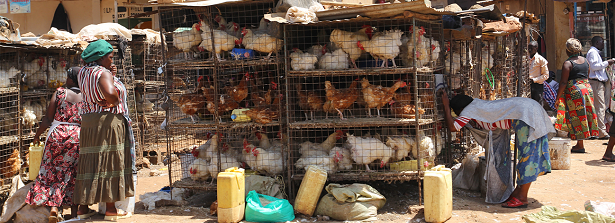Poultry development in Eastern Africa, What next?

The poultry sector in Eastern Africa has been growing rapidly for the past five years driven by rapid urbanization, the growth of the middle class, a rise in number of quick services restaurants in urban areas, and growing need for animal protein. As a result, poultry production has gradually grown from a mainly backyard keeping system to a more professional and commercial value chain. A study and learning trajectory of NABC and Wageningen University & Research analyse the way in which national poultry value chains in Kenya, Uganda, Tanzania and Rwanda are influenced by the dependency on inputs from and market outlets in other countries in the region.
The growth of the poultry sector in the various countries has however not been equal. The economy of some countries (South Africa, Kenya and previously also Zimbabwe) is much stronger than the economy of the surrounding countries and this is also reflected in the dimension of the poultry sector. This has inevitably led to a situation whereby the poultry sector in some countries depends on the poultry sector in other countries, e.g. for inputs (day old chicks, vaccines) or for market outlets of eggs and poultry meat. This interdependency is not necessarily always conducive for a more sustainable development of poultry sectors. Dependence on a stronger economy in a neighbouring country can lead to inadequate investment in competitive approaches for poultry development in particular countries.
The Netherlands is very active in poultry development in Africa. Private companies, educational and research institutes, NGO’s and the Dutch government are all involved in various aspects of developing the poultry sector. To harmonize the country-oriented Dutch investments and development with increasing regional influences in poultry value chain developments, better insight is needed in the interdependency of the poultry sectors of different countries. This is why a study and learning trajectory was initiated by NABC and Wageningen University & Research, funded by the Food & Business Knowledge Platform (F&BKP). The study and learning trajectory analyse the way in which national poultry value chains in Kenya, Uganda, Tanzania and Rwanda are influenced by the dependency on inputs from and market outlets in other countries in the region.
The learning trajectory included a consultation on the set-up of the study with the Dutch Africa Poultry Partners (DAPP, the poultry sector platform of NABC) on May 10, 2017. The preliminary findings were presented at the Poultry East Africa Day of NABC and the Dutch Poultry Centre on June 21, 2017; at the Poultry Africa Exhibition and Conference in Kigali, Rwanda on October 10, 2017 and again to the DAPP on February 28, 2018. The final results of the study were presented during the ViV Europe on June 22, 2018. The full report can be found here (PDF).
Main results of the study
Of the four Eastern African countries included in the study, Kenya’s poultry sector is the most mature. However, all the other three economies have made significant strides towards developing and growing their own poultry sector in the past five years.
In order to justify the case for regional approach to poultry development in Eastern Africa, three key issues were addressed.
- First the availability and production of good quality feed at competitive prices. Governments in the region have made conscious policy changes to incentivize the import of raw materials and ingredients for feed into the region. In addition to this, certain countries in Eastern Africa such as Tanzania and Rwanda have made poultry specific strategies to catalyse growth of their poultry sectors. Whereas collective initiatives are in principal good for sectoral development at a regional level, history shows that there are the significant challenges to overcome. For instance clarity on cross border trade in maize, oil seeds and oil seed cake is necessary for a sound regional approach to feed. The disparity in terms of available land for maize cultivation, the cost price and eventual market price for maize differs significantly per country in Eastern Africa. Each county in Eastern Africa has a competitive advantage that could complement the others. However finding these complementarities and capitalising them for the greater good of the region will give rise to significant benefits for each Eastern Africa member state.
- Secondly the availability of Day Old Chicks (DOCs) across Eastern Africa is a challenge. Kenya trades with Uganda and Uganda trades with Rwanda when it comes to DOCs. There is a shortage of DOCs in EA and there is a seasonality both in availability and price that makes it difficult for farmers to plan ahead and manage their costs.
- Lastly access to markets; the East African Community (EAC) is both an economic and political block. Citizens of the member states are in principal allowed to work, do business and trade with one another freely. Though the EAC is the most advanced regional economic block in Africa it still faces certain challenges to implementing certain policies collectively. For instance in February of 2018 all EA member states agreed to remove VAT on all raw materials imported for feed manufacturing. Of the four member states, three have already tabled this policy in parliament and one has not. Free access to a market of approximately 140 million people will drive investments in the sector across the entire value chain. Such initiatives should be given priority and expedited in order to catalyse investments and growth in the Eastern Africa poultry sector.
Complimentary to the three issues above is knowledge and training at vocational and tertiary levels in Eastern Africa. There is need for better and more specific training and education in the poultry sector. A case in point is in Eastern Africa veterinary doctors are in principal experts for all livestock and poultry is one amongst many of the courses they would take during their four to six years study. Upon completion most are not equipped to immediately enter into the poultry sector. Most farms and companies in the sector have been forced to develop on job training programs that allow high performers to learn poultry specific knowledge. In addition to knowledge and training collective investment in regulation and enforcement of good biosecurity and animal health practices would go a long way to reduce and or manage disease outbreaks in the region.
In the context of this study it is observed that in Eastern Africa a majority of poultry farmers are either small or medium scale farmers. Collective investments in feed, DOCs, animal health, knowledge transfer, capacity building, training and access to markets will greatly assist them become better farmers. In recognition of the increased significance of the poultry sector various financing and financial institutions have become interested in poultry farmers and other poultry sector value chain actors. These developments coupled with increasing demand for animal protein make the sector very attractive not only for local actors but also for the Dutch private sector.







Breeding chicks in Africa, specifically Kenya as it has good trade links and routes with the UK and the ‘developed’ world should be paramount.
We now have intensively farmed in the western world for decades we have a wealth of information to pass onto other regions. From feed to production ratios and nutrient vs cost. Large scale commerical farming operations in the USA, UK & EU should be asked to open source alot of their ‘sharp end’ findings then work Not for profit org’s to help implement the on the ground action. i.e setting up shop.
Another course of action is the specific chicken breeds that regions should improve uptake on. There are certain breeds of chickens that are nearly self sustainable. i.e require very little to no amount of feed. These arent the high production breeds we see in battery farms today. They are still laying 200+ eggs per annum on all accounts for no input thats a great output. Rural communities could really benefit from developing such breeds to show their effectiveness and then breeding programmes can begin.
Has anyone looked into shipping by air chickens that are due for slaughter in commercial farms after ‘molt’, to regions in northern Africa?
As study by james madison university in the US shows that eggs from free range chickens contains more omega 3’s plus more vitamin E & A. Chickens that are out foraging are free range so the benefits are two fold.
Sources:
http://www.poultrypages.com
James Madison University